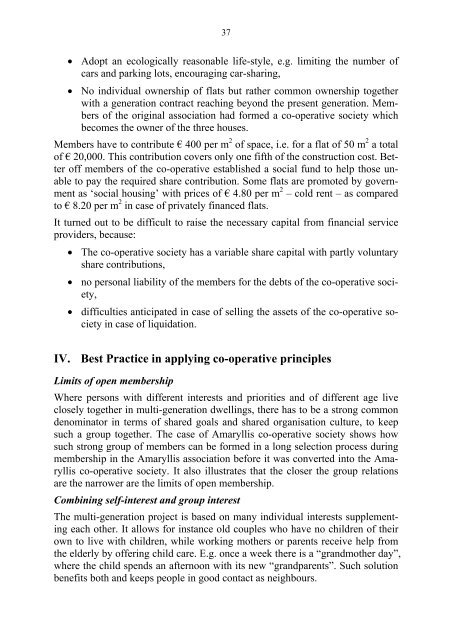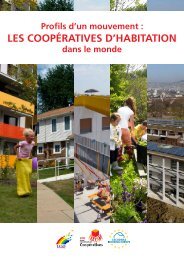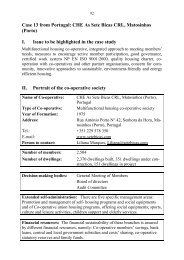Case 5 from Germany Amaryllis Co-operative Society ... - ICA Housing
Case 5 from Germany Amaryllis Co-operative Society ... - ICA Housing
Case 5 from Germany Amaryllis Co-operative Society ... - ICA Housing
You also want an ePaper? Increase the reach of your titles
YUMPU automatically turns print PDFs into web optimized ePapers that Google loves.
37<br />
• Adopt an ecologically reasonable life-style, e.g. limiting the number of<br />
cars and parking lots, encouraging car-sharing,<br />
• No individual ownership of flats but rather common ownership together<br />
with a generation contract reaching beyond the present generation. Members<br />
of the original association had formed a co-<strong>operative</strong> society which<br />
becomes the owner of the three houses.<br />
Members have to contribute € 400 per m 2 of space, i.e. for a flat of 50 m 2 a total<br />
of € 20,000. This contribution covers only one fifth of the construction cost. Better<br />
off members of the co-<strong>operative</strong> established a social fund to help those unable<br />
to pay the required share contribution. Some flats are promoted by government<br />
as ‘social housing’ with prices of € 4.80 per m 2 – cold rent – as compared<br />
to € 8.20 per m 2 in case of privately financed flats.<br />
It turned out to be difficult to raise the necessary capital <strong>from</strong> financial service<br />
providers, because:<br />
• The co-<strong>operative</strong> society has a variable share capital with partly voluntary<br />
share contributions,<br />
• no personal liability of the members for the debts of the co-<strong>operative</strong> society,<br />
• difficulties anticipated in case of selling the assets of the co-<strong>operative</strong> society<br />
in case of liquidation.<br />
IV. Best Practice in applying co-<strong>operative</strong> principles<br />
Limits of open membership<br />
Where persons with different interests and priorities and of different age live<br />
closely together in multi-generation dwellings, there has to be a strong common<br />
denominator in terms of shared goals and shared organisation culture, to keep<br />
such a group together. The case of <strong>Amaryllis</strong> co-<strong>operative</strong> society shows how<br />
such strong group of members can be formed in a long selection process during<br />
membership in the <strong>Amaryllis</strong> association before it was converted into the <strong>Amaryllis</strong><br />
co-<strong>operative</strong> society. It also illustrates that the closer the group relations<br />
are the narrower are the limits of open membership.<br />
<strong>Co</strong>mbining self-interest and group interest<br />
The multi-generation project is based on many individual interests supplementing<br />
each other. It allows for instance old couples who have no children of their<br />
own to live with children, while working mothers or parents receive help <strong>from</strong><br />
the elderly by offering child care. E.g. once a week there is a “grandmother day”,<br />
where the child spends an afternoon with its new “grandparents”. Such solution<br />
benefits both and keeps people in good contact as neighbours.





